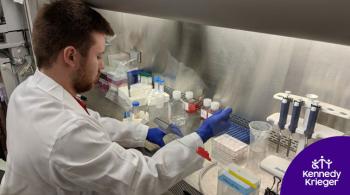BALTIMORE, September 10, 2025 — A new study from Kennedy Krieger Institute shows that a specialized MRI scan can detect changes in the brain years before memory problems begin. The findings offer hope for earlier diagnosis and better treatment of Alzheimer’s disease.
In the research, published in Radiology, scientists followed 158 older adults for up to 7 years who had no signs of memory or thinking problems at the start of the study. Using a technique called quantitative susceptibility mapping (QSM) MRI, they looked for small changes in brain tissue linked to iron levels. Increased iron is known to drive neurodegeneration.
They found that higher iron levels in two key brain areas, the entorhinal cortex and the putamen, predicted which participants would later develop mild cognitive impairment. This impairment often precedes Alzheimer’s disease. These changes were spotted years before symptoms appeared and were especially strong in people who also had elevated levels of amyloid, a protein tied to Alzheimer’s.
The research was led by Dr. Xu Li, a research associate in the F.M. Kirby Research Center for Functional Brain Imaging at Kennedy Krieger Institute, who said the impacted areas of the brain play a central role in memory and learning.
“Our goal is to identify brain changes linked to Alzheimer’s that occur years before major memory loss,” said Dr. Li. “If we can detect these changes earlier and better identify patients at higher risks of developing Alzheimer’s, we have a better chance of slowing or even preventing progression through targeted therapies.”
Key findings from the research include:
- Brain scans spotted tiny iron-related changes years before memory loss began.
- These changes predicted who would develop mild cognitive impairment and how quickly decline would happen.
- The risk was highest in people who also had an accumulation of abnormal amyloid proteins, a hallmark of Alzheimer’s disease.
The study is one of the first to show that QSM MRI, a tool already available in many hospitals, can flag people at higher risk for Alzheimer’s years in advance. Researchers say it could also be used to enroll the right participants in clinical trials and track whether new treatments are working.
“This technology is giving us a new map of the brain showing important biomarkers related to Alzheimer’s before it takes hold,” Dr. Li said. “My hope is patients and families will someday receive access care and potentially better treatments sooner and take time plan for the future with their families.”
The Kennedy Krieger team plans to continue following study participants to learn more about how brain iron and other biological changes work together to drive memory loss and how they might be targeted to prevent it.
###
About Kennedy Krieger Institute
Kennedy Krieger Institute, an internationally known, non-profit organization located in the greater Baltimore/Washington, D.C. region, transforms the lives of nearly 30,000 individuals a year through inpatient and outpatient medical, behavioral health and wellness therapies, home and community services, school-based programs, training and education for professionals and advocacy. Kennedy Krieger provides a wide range of services for children, adolescents and adults with diseases, disorders or injuries that impact the nervous system, ranging from mild to severe. The Institute is home to a team of investigators who contribute to the understanding of how disorders develop, while at the same time pioneer new interventions and methods of early diagnosis, prevention and treatment. Visit www.kennedykrieger.org/ for more information about Kennedy Krieger.















